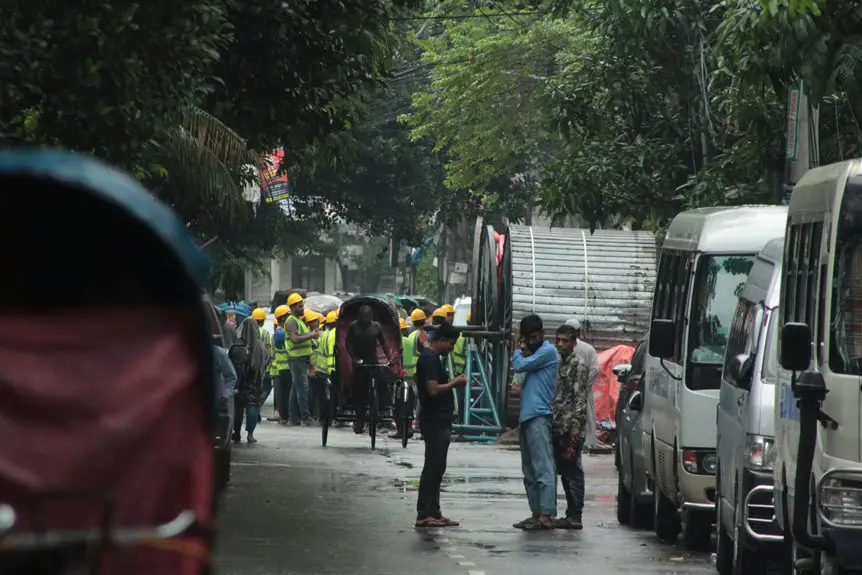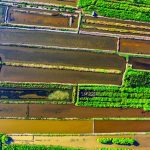In road construction, geotextiles are durable fabrics you use to strengthen soil, improve drainage, and prevent layers from mixing. You’ll find they stabilize weak soil by evenly distributing loads, which extends road life and reduces maintenance. They also let water pass while holding back soil, fighting erosion and boosting durability. Since they’re eco-friendly and support sustainability, they’re a smart choice. If you keep exploring, you’ll discover how installation methods and environmental benefits play key roles.
Table of Contents
Key Takeaways
- Geotextiles are synthetic permeable fabrics used to improve soil stability and drainage in road construction.
- They serve functions like soil separation, reinforcement, and filtration to enhance road durability.
- Woven, non-woven, and knitted are the main types, each offering different strength and filtration properties.
- Proper installation involves laying geotextiles flat, overlapping seams, and securing edges to prevent soil mixing.
- Using geotextiles extends road lifespan, improves load distribution, and supports effective water management.
Definition and Types of Geotextiles
Although you mightn’t always see them, geotextiles play an essential role in road construction by improving soil stability and drainage. Geotextiles are permeable fabrics made from synthetic materials like polypropylene or polyester. When you use them, they allow water to pass through while preventing soil particles from moving, which helps maintain the road’s integrity.
There are three main types: woven, non-woven, and knitted. Woven geotextiles resemble fabric made by interlacing threads and offer high tensile strength. Non-woven types are more like felt and excel in filtration and drainage. Knitted geotextiles combine features of the other two but are less common.
Choosing the right type depends on your project’s specific needs, such as load-bearing or water management requirements.
Role of Geotextiles in Soil Stabilization
Geotextiles serve three key functions in soil stabilization: separation, reinforcement, and filtration. When you use geotextiles, you prevent different soil layers from mixing, which maintains the integrity of each layer and extends the road’s lifespan.
They also reinforce weak soil by distributing loads more evenly, so you avoid uneven settlement and rutting. Additionally, geotextiles allow water to pass through while holding back soil particles, which prevents erosion and improves drainage.
Methods of Geotextile Installation in Road Construction
Proper installation techniques play an essential role in maximizing the benefits of geotextiles in road construction.
When you install geotextiles, start by preparing a smooth, debris-free subgrade to prevent damage. Roll out the geotextile evenly, guaranteeing it lies flat without wrinkles or folds. Overlap adjacent sheets by at least 30 cm to maintain continuity and prevent soil intrusion.
Secure the edges with pins or staples to keep the fabric in place during backfilling. When placing fill material, spread it gently to avoid tearing the geotextile. Avoid heavy machinery directly on the fabric before coverage.
Benefits of Using Geotextiles in Road Projects
When you use geotextiles in road projects, you improve soil stabilization, which helps prevent shifting and settling.
You’ll also boost drainage efficiency, allowing water to flow through without damaging the road structure.
These benefits make roads stronger and longer-lasting with less maintenance.
Soil Stabilization Advantages
Although soil conditions can vary widely, using geotextiles in road construction greatly enhances soil stabilization.
When you incorporate geotextiles, you improve the soil’s strength and durability, making your road foundation more reliable.
Here are three key advantages you’ll notice:
- Load Distribution: Geotextiles help spread heavy loads evenly, reducing soil deformation and preventing rutting under traffic.
- Separation: They keep different soil layers from mixing, preserving the integrity of each layer and maintaining the design’s load-bearing capacity.
- Reinforcement: Geotextiles add tensile strength to weak soils, allowing you to build roads on challenging terrains without excessive excavation.
Enhanced Drainage Efficiency
Anyone working on road construction knows drainage is essential to a project’s longevity. When you use geotextiles, you enhance drainage efficiency by allowing water to pass through while preventing soil particles from clogging drainage layers.
This separation keeps the drainage system functioning effectively, reducing water buildup that can weaken the road base. By improving water flow, geotextiles help you avoid costly repairs caused by erosion or pavement deformation.
They also speed up construction by stabilizing wet areas quickly, letting you work without delays. In short, incorporating geotextiles means you’ll maintain a solid, dry foundation, extend the road’s lifespan, and save on maintenance costs.
Using these fabrics is a smart move for any road project focused on durability and performance.
Geotextiles for Drainage and Filtration
Since proper water management is essential in road construction, geotextiles play an important role in drainage and filtration systems.
Effective water management in road construction relies heavily on geotextiles for drainage and filtration.
When you use geotextiles, you improve water flow while preventing soil particles from clogging drainage layers. Here’s how they help:
- Filtration: Geotextiles let water pass through but block fine soil particles, maintaining drainage efficiency.
- Drainage: They create a pathway for water to flow away from the road base, reducing hydrostatic pressure.
- Separation: By keeping different soil layers apart, geotextiles prevent mixing that could disrupt drainage performance.
Comparative Analysis: Geotextiles Vs Traditional Materials
When you compare geotextiles to traditional materials like gravel or sand, you’ll find geotextiles offer distinct advantages in durability, cost-effectiveness, and installation speed.
Unlike bulky aggregates, geotextiles are lightweight and easy to handle, which speeds up your road construction projects. They provide excellent separation and reinforcement, preventing soil mixing and reducing maintenance needs over time.
Traditional materials often require more frequent replacement and larger quantities, driving up costs and labor. Geotextiles also enhance drainage without clogging, unlike some conventional materials that can retain water and weaken the road base.
While gravel and sand still have their place, geotextiles give you a modern, efficient solution that boosts performance and saves you time and money in the long run.
Environmental Impact and Sustainability of Geotextiles
You’ll find that using eco-friendly geotextiles can greatly reduce your project’s carbon footprint.
These materials also play a key role in enhancing soil conservation by preventing erosion and promoting stability.
Let’s explore how these benefits contribute to more sustainable road construction practices.
Eco-friendly Material Benefits
Although road construction often raises environmental concerns, geotextiles offer eco-friendly benefits that can greatly reduce your project’s impact. By integrating these materials, you actively promote sustainability while maintaining road quality.
Here’s how geotextiles help:
- Soil Preservation: They prevent erosion and maintain soil stability, reducing the need for extensive earthworks.
- Resource Efficiency: Geotextiles minimize the requirement for natural aggregates, conserving raw materials.
- Longevity: Their durability extends the lifespan of roads, cutting down on frequent repairs and associated waste.
Using geotextiles means you’re not only supporting structural integrity but also making a conscious choice to protect the environment, ensuring your road projects are greener and more sustainable.
Reducing Carbon Footprint
Building on the eco-friendly benefits of geotextiles, you can also substantially cut down your project’s carbon footprint.
Geotextiles reduce the need for natural materials like gravel or sand, which means less extraction and transportation, both major sources of CO2 emissions. By improving soil stability and drainage, they extend the lifespan of roads, so you won’t need frequent repairs or reconstruction, saving energy and materials over time.
Additionally, many geotextiles are made from recycled or recyclable materials, helping you lower waste and resource consumption.
Choosing geotextiles means you’re embracing a sustainable solution that minimizes environmental impact while maintaining road quality.
This way, you contribute to greener construction practices and help fight climate change without compromising performance.
Enhancing Soil Conservation
When you incorporate geotextiles into road construction, they play an essential role in preserving the soil beneath and around the roadway. These materials help maintain soil integrity and prevent erosion, ensuring long-term stability and sustainability.
Here’s how geotextiles enhance soil conservation:
- Erosion Control: They act as a barrier, protecting soil from wind and water erosion during and after construction.
- Soil Stabilization: By reinforcing weak soils, geotextiles prevent shifting and settling that can degrade road foundations.
- Water Management: They allow water to pass through while retaining soil particles, reducing runoff and preserving natural soil structure.
Common Challenges and Solutions in Geotextile Application
Since geotextiles play an essential role in road construction, you’ll often face challenges like improper installation, material damage, and drainage issues.
To avoid improper installation, guarantee the surface is clean and smooth before laying the fabric and overlap seams correctly to prevent soil infiltration. Protect the geotextile from sharp objects or heavy machinery to minimize material damage.
Using proper handling and storage techniques helps maintain its integrity.
Drainage problems often occur if the geotextile clogs with fine particles; selecting the right type with appropriate permeability and performing regular inspections can solve this.
Addressing these challenges proactively guarantees your geotextile performs well, enhancing road stability and longevity while preventing costly repairs down the road.
Frequently Asked Questions
How Long Do Geotextiles Typically Last in Road Construction?
You can expect geotextiles to last anywhere from 10 to 50 years in road construction, depending on material quality and environmental conditions. They’ll degrade faster if exposed to UV or chemicals, so proper installation matters.
Can Geotextiles Be Recycled After Road Project Completion?
Think of geotextiles as the fabric of a well-worn jacket; you can recycle them, but it’s tricky. You’ll often need specialized facilities to process and reuse them properly after your road project finishes.
Are Geotextiles Safe for Use Around Wildlife Habitats?
You can safely use geotextiles around wildlife habitats if you choose biodegradable or non-toxic materials. They prevent soil erosion without harming animals, but always check the product’s environmental certifications to protect local ecosystems effectively.
What Is the Cost Comparison of Geotextiles Versus Traditional Materials?
Like choosing between a knight’s armor and chainmail, you’ll find geotextiles often cost more upfront but save money over time with durability and reduced maintenance, unlike traditional materials that may require frequent repairs.
How Do Weather Conditions Affect Geotextile Performance in Roads?
You’ll find geotextiles perform well in various weather, but extreme heat can degrade them faster, and heavy rain may reduce effectiveness. Proper installation helps you maintain durability despite these weather challenges.
- The Use of Nonwovens in Construction and Civil Engineering - July 11, 2025
- The Use of Nonwovens in Construction and Civil Engineering - July 11, 2025
- The Use of Nonwovens in Construction and Civil Engineering - July 11, 2025







